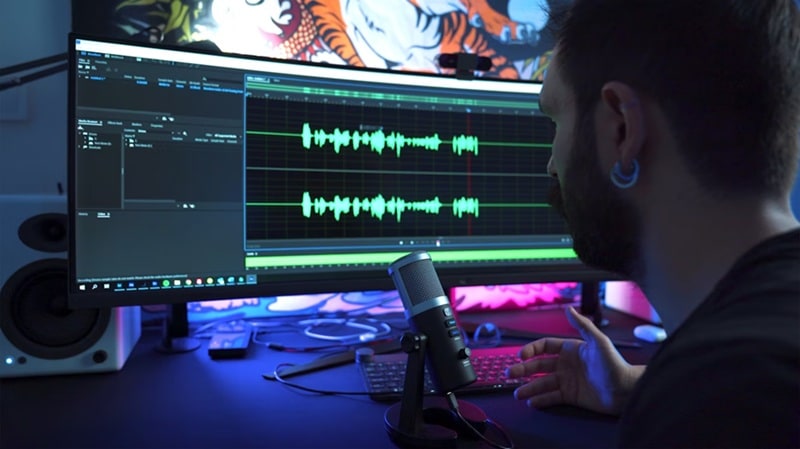WAV and MP3 are among the most common audio formats used by people, but many are still confused about which one to use and when, and what the differences are between them. They do contain the sound, but they’re actually built for different things.
If you want to level up your audio editing or production skills, understanding the differences between WAV vs MP3 will help you make smarter choices when exporting or working with sound.
This breakdown will walk you through how each format works, its pros and cons, and when to use one over the other. And as a result, you won’t make a random guess anymore when exporting your audio.

Part 1. The Differences Between MP3 and WAV at a Glance
Before we get into more details on the “MP3 vs WAV” discourse, you can take a quick look at this comparison to get the gist of what sets them apart:
| Feature | MP3 | WAV |
| Compression Type | Uses lossy compression to reduce file size | Stores audio without compression or loss |
| File Size | Smaller and easier to share or upload | Larger and takes up more storage space |
| Audio Quality | Slightly reduced quality, depends on bitrate | High-quality audio with full detail |
| Compatibility | Works on almost every device and platform | Widely supported but not ideal for quick streaming |
| Editability | Not suitable for heavy editing due to loss of data | Great for editing and audio production |
| Ideal Use Cases | Streaming, podcasts, and everyday listening | Professional recording, video editing, and archiving |
Part 2. What is MP3?
MP3 (short for MPEG-1 Audio Layer 3) became popular because of how well it balances sound quality with small file size.
What makes MP3 different from WAV and other audio formats is its lossy compression. This means it gets rid of parts of the audio that are considered less noticeable to human ears. The result is a much smaller file that still sounds good enough for most people. This feature makes MP3 the perfect choice for music streaming, podcasts, and quick sharing online.

How MP3 Compression Works
MP3 uses a type of audio compression that analyzes the frequencies in a sound file and removes those that are either too high or too low to be clearly heard. It also reduces redundancy and repetitive data to make the file more efficient. As a result, it’s capable of shrinking the file size without making the audio sound bad.
Pros and Cons of MP3
Bitrate Options and Quality Trade-Offs
MP3 files are often labeled with bitrates, like 128 kbps, 192 kbps, or 320 kbps. These numbers tell you how much audio data is processed every second.
- 128 kbps: Decent for casual listening, but may sound slightly muffled
- 192 kbps: A nice balance between quality and size for most users
- 320 kbps: Almost indistinguishable from uncompressed formats for most ears

The higher the bitrate, the better the sound quality, but also the larger the file size. So, picking the right bitrate depends on how you plan to use the file. For background music or casual listening, lower bitrates are usually fine.
But if you want top-tier sound, go for 320 kbps or use WAV instead.
Part 3. What is WAV?
WAV (Waveform Audio File Format) is an audio format often used in professional audio and video production. The biggest difference compared to MP3 is that WAV files are uncompressed. They keep every bit of audio data exactly as it was recorded.

WAV vs MP3 Audio Quality
Since WAV doesn’t toss out any audio data, the quality is crystal clear. You get full detail, wider frequency range, and more dynamic depth. It makes WAV a popular format used in studios for recording vocals, instruments, and voice-overs.
WAV is also great for editing. Since there’s no compression messing with the sound, you can cut, mix, or process the audio without losing quality. Music producers, sound designers, and video editors need this precision and flexibility to fine-tune every detail, layer multiple tracks, and apply effects without worrying about degrading the original sound.

Is a WAV file better than MP3?
In terms of audio quality, yes. But it also comes with larger file sizes, which might not be ideal for casual listening, streaming, or sharing online.
Pros and Cons of WAV
Part 4. Which Audio Format Should You Choose: MP3 or WAV?
So, which is better? WAV or MP3? At the end of the day, the best format depends on what you’re doing with your audio. MP3 is lightweight, flexible, and easy to share. Meanwhile, WAV gives you a full-quality sound and editing freedom.
So, if you’re after convenience and quick delivery, MP3 will get the job done. But if quality is your top priority, WAV is the format.
Use MP3 If:
- ✅ You’re uploading music or audio to streaming platforms or websites
- ✅ You want smaller file sizes that are easier to store or share
- ✅ You’re creating background music or casual content where perfect sound isn’t a must
Use WAV If:
- ✅ You’re recording vocals, instruments, or any high-quality audio content
- ✅ You plan to edit, mix, or master the audio later on
- ✅ You need clean and lossless audio for professional video or film production

Both formats serve different purposes. The best audio format is the one that fits your project best. And remember, you can always export in WAV first and convert to MP3 later if needed.
Bonus: Best All-in-One MP3 and WAV Editor and Converter
If you need a tool that can handle both MP3 and WAV on one platform, you can use Wondershare Filmora. Filmora gives you everything you need to cut, mix, clean up, and export audio with ease. It's designed to help creators work fast without sacrificing quality.
You can open your MP3 or WAV file, edit it with precision, and export it in the format you prefer. Filmora works great for podcasters, musicians, voiceover artists, and content creators who want more control over their sound.

Why Filmora Is a Great Choice for Audio Editing
- Supports many file formats. MP3, WAV, AAC, FLAC, and more. You won’t need to convert files before you start editing.
- Precise audio timeline. You can adjust volume levels, apply fades, sync audio with video, and cut clips with frame accuracy.
- Audio plugin compatibility. Filmora supports VST plugins, which means you can add pro effects like EQ, reverb, and vocal tuning right inside your project.
- AI Audio Enhancer. Clean up noisy audio and improve sound quality in just one click. This tool helps boost volume and clarity instantly.
- Built-in voice recorder and sound effects. Record your own voice and use a large collection of background music and sound effects to enhance your audio.
- Custom export settings. Choose the output format you want and set the bitrate and sample rate to match your project needs. You can export in MP3 for smaller files or WAV for full quality.
Conclusion
Knowing how to get the best out of your audio starts with understanding the difference between MP3 vs WAV. If you care more about high-quality sound and plan to do a lot of editing, you can go with WAV. But for quick uploads, casual listening, or music streaming, MP3 is usually better.
Each format has its place, and now you know which format fits your project more. If you need a tool that handles both formats without the hassle, Filmora makes it simple to edit, clean up, and export your audio the way you want.
FAQs
-
1. Does converting WAV to MP3 reduce quality?
Yes, converting WAV to MP3 will slightly reduce the audio quality. That’s because MP3 uses lossy compression, which removes some sound data to make the file smaller. The difference might not be obvious to everyone, but audio purists can usually tell. -
2. Can I use WAV files on mobile devices?
You can, but keep in mind that WAV files are large and can take up a lot of storage. Most mobile players support WAV, but it’s not ideal if your phone has limited space or if you’re trying to stream the audio. -
3. Do streaming services use MP3 or WAV?
Most streaming platforms use compressed formats like MP3 or AAC to deliver music efficiently. WAV files are just too big to stream smoothly, so they’re usually reserved for behind-the-scenes use during audio mastering or uploading before compression. -
4. Should I choose MP3 or WAV for YouTube?
MP3 works fine for YouTube uploads if you just want something quick and easy. But if you’re aiming for the best possible sound in your final video, start with WAV. YouTube will compress it either way, but uploading a clean WAV gives you better results after processing.



 100% Security Verified | No Subscription Required | No Malware
100% Security Verified | No Subscription Required | No Malware

